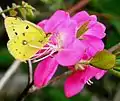Colias erate
Colias erate, the eastern pale clouded yellow, is a butterfly in the family Pieridae. It is found from south-eastern Europe, through Turkey over central Asia up to Japan and Taiwan. To the south, its range stretches to Somalia and Ethiopia. The species was first described by Eugenius Johann Christoph Esper in 1805.[1] [2]
| Eastern pale clouded yellow | |
|---|---|
 | |
| C. e. poliographus | |
| Scientific classification | |
| Kingdom: | Animalia |
| Phylum: | Arthropoda |
| Class: | Insecta |
| Order: | Lepidoptera |
| Family: | Pieridae |
| Genus: | Colias |
| Species: | C. erate |
| Binomial name | |
| Colias erate (Esper, 1805) | |
| Synonyms | |
| |
The wingspan is 23–26 mm. The butterfly flies in May to September in two generations.
The larvae feed on various Fabaceae species, such as Medicago sativa and Medicago, Trifolium, Onobrychis and Melilotus species.
Subspecies
- C. e. erate (Ukraine, Turkey, Lebanon, Bulgaria, Romania, Macedonia, Greece, Hungary, Austria, Turkmenistan, Kazakhstan, Kirhizia, Uzbekistan, Tajikistan, Afghanistan)
- C. e. amdensis Verity, 1911 (China: Qinghai, Gansu, Sichuan)
- C. e. marnoana Rogenhofer, 1884 (Sudan, Ethiopia, south-western Arabia)
- C. e. sinensis Verity, 1911 (Mandschuria, North Korea)
- C. e. formosana Shirôzu, 1955 (Taiwan)
- C. e. lativitta Moore, 1882 (Nepal, northern India)
- C. e. poliographus Motschulsky, 1860 (Mongolia, Japan, Amur, Ussuri, Sakhalin, Tian Shan)
- C. e. tomarias Bryk, 1942 (Kuriles)
- C. e. naukratis Fruhstorfer, 1909 (Altai, southern Siberia, Transbaikalia)
- C. e. nilagiriensis C. & R. Felder, 1859 (southern India)
Description
Frederic Moore (1882) gives a detailed description for C. e. lativitta:
Male. Yellow: fore wing with a broad unspotted blackish band,the inner border of which is angulated inward at the upper median vein; the band very sparsely yellow-speckled on the anterior veins; discocellular spot large, black: hind wing with a broad blackish crenulated band and a large orange-yellow discocellular spot. Underside olivaceous yellow: fore wing with a black discocellular spot and a distinct discal row of spots: hind wing with a moderate-sized dull pearly-white red-bordered discocellular spot.
Female. Yellow, or white; the band on fore wing broader than in male, and with not very prominent upper and lower yellow spots; the discocellular spot distinct: hind wing darker, with broad marginal band traversed inwardly by large ill-defined yellow spots; discocellular spot brighter red.
Expanse 1 5/8 to 2 2/8 inches.
Gallery
 C. e. erate Ventral view (male)
C. e. erate Ventral view (male) C. e. erate Dorsal view (male)
C. e. erate Dorsal view (male) C. e. erate Ventral view (female)
C. e. erate Ventral view (female) From Japan
From Japan Feeding on nectar of Rhododendron albrechtii
Feeding on nectar of Rhododendron albrechtii
Cited references
- Savela, Markku. "Colias erate (Esper, 1805)". Lepidoptera and Some Other Life Forms. Retrieved July 1, 2018.
- Varshney, R.K.; Smetacek, Peter (2015). A Synoptic Catalogue of the Butterflies of India. New Delhi: Butterfly Research Centre, Bhimtal & Indinov Publishing, New Delhi. p. 23. doi:10.13140/RG.2.1.3966.2164. ISBN 978-81-929826-4-9.
-
 One or more of the preceding sentences incorporates text from a work now in the public domain: Moore, Frederic (1882). Proceedings of the Zoological Society of London. p. 255.
One or more of the preceding sentences incorporates text from a work now in the public domain: Moore, Frederic (1882). Proceedings of the Zoological Society of London. p. 255.
External links
- Russian Insects poliographus Motschulsky, 1860
- www.lepiforum.de - taxonomy and photos
- www.schmetterling-raupe.de
- Moths and Butterflies of Europe and North Africa
- Fauna Europaea
| Wikimedia Commons has media related to Colias erate. |
